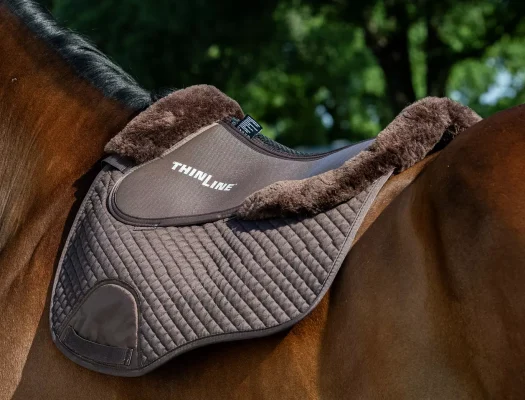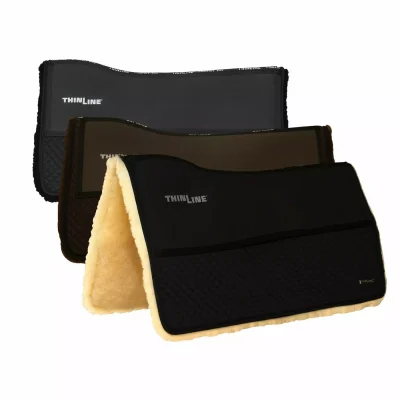
What Are Breathable Saddle Pads – Use Case & Benefits
For anyone who regularly rides horses, observing a horse’s back saturated and steaming from sweat after a ride is not uncommon. Many riders may believe that excessive heat and moisture after a hard ride is relatively harmless, but that isn’t the case.In fact, it can indicate compromised thermoregulation that can cause discomfort and directly impact a horse’s health, attitude, and athletic performance.
Thermoregulation refers to the physiological processes that occur in a horse’s body to maintain its stable core body temperature within a range (approximately 99 – 101.5℉). Sweating plays a vital role in thermoregulation. As body temperature starts to rise, the brain signals the sweat glands to produce sweat, releasing it onto the skin’s surface. With evaporation, the released sweat is absorbed and carries away heat, cooling down the horse’s body.
Traditional saddle pads provide cushioning, but their dense, non-permeable construction can inhibit evaporation, causing trapped heat and sweat to create a micro-environment akin to a sauna against the horse’s skin. This condition is particularly acute during strenuous work, in hot climates, or over long-duration rides.
The modern solution to this challenge is the technologically advanced breathable saddle pad. Far from being a trend, it represents a fundamental shift toward prioritizing equine comfort and physiological health.
These ThinLine pads are specifically engineered to mitigate the problems of heat, moisture, and pressure, offering a superior standard of support for the equine athlete.
The Physiological Benefits of Advanced Saddle Pad Technology
The advantages of a high-quality breathable pad are not marginal; they are substantial improvements that directly contribute to the protection and health of the horse’s back.
1. Superior Thermoregulation: Combating Heat Stress
A primary benefit of a breathable saddle pad is its capacity for effective heat dissipation. During exercise, a horse’s powerful back muscles generate significant metabolic heat.
A conventional pad insulates this area, preventing cooling and leading to a cascade of adverse effects, including discomfort, premature fatigue, and skin problems. A breathable pad fundamentally alters this dynamic.
How these pads combat heat:
- Promote Continuous Airflow: Open-cell or mesh structures allow for constant convective cooling as the horse moves.
- Reduce Subdermal Temperatures: Studies and field reports indicate a significant temperature reduction under the saddle—in some cases by as much as 14.4°F – which is physiologically advantageous for the horse.
- Prevent “Hot Spots”: By distributing heat evenly and allowing it to escape, these pads prevent the formation of concentrated high-temperature zones.
- Enhance Performance and Stamina: A cooler, more comfortable horse is less prone to fatigue and able to perform at a higher level for longer.
Such technology functions as an active cooling system under the saddle.
2. Effective Moisture Management: Preventing Skin Compromise
Beyond heat, managing moisture is essential. While perspiration is a natural cooling mechanism, sweat trapped against the skin creates an environment ripe for chafing, bacterial or fungal growth, and follicle damage, which can lead to sores and white hairs.
A quality breathable pad is designed to wick moisture away from the horse’s coat and facilitate rapid evaporation.
Why moisture management is critical:
- Active Wicking: Materials like technical mesh or performance wool actively draw moisture from the hair to the pad’s surface to be evaporated.
- Reduced Risk of Dermatological Issues: A drier back is a healthier back, discouraging the proliferation of microbes that thrive in damp, anaerobic conditions.
- Rapid Pad Drying Time: The pad itself dries significantly faster, improving hygiene and convenience.
- Healthier Coat and Skin: Proper moisture wicking prevents the hair follicles from becoming oversaturated and damaged.
Increased moisture vapor transfer is a game-changing improvement for skin health.
3. Impact Absorption and Pressure Distribution
The term “breathable” may evoke thoughts of airflow, but these pads also offer significant biomechanical advantages.
Many designs promote ‘springiness’ that provides superior shock absorption and distributes saddle and rider pressure more evenly across the horse’s back.
ThinLine Saddle Pads Meet These Essential Criteria
ThinLine dedicates itself to developing and constructing saddle pads for all riding disciplines that provide the just-described three elements of advanced saddle pad technology:
- superior thermoregulation
- effective moisture management
- impact absorption and pressure distribution
Because of ThinLine’s patented open-cell foam technology, it resists compression while providing unmatched shock absorption and pressure distribution, making it the only saddle pad endorsed by back surgeons, master saddlers, and veterinarians.
But that’s not all.
ThinLine has gone to great lengths to design saddle pads that keep horses cool and dry regardless of their riding discipline.
For example, dressage riders looking for a show-worthy pad that absorbs sweat well will love the Woven Wool Square Dressage Pad.

Made with Merino wool that is needled onto a fabric backing, the wool is soft, absorbent, and cooling on the horse’s back. (Needling is a manufacturing process that leverages the interlocking of fibers to create a durable textile.)
The wool quality, length, and density are more consistent than wool on a natural hide, and its longevity is superior too. And woven wool is machine washable.
ThinLine offers other pads with woven wool.
The Woven Wool Western Saddle Pad and the Woven Wool Euro Roll Jumper Pad are also constructed by needling the Merino wool onto a fabric backing.
In addition to the wool’s excellent absorbency, these pads offer a 3D mesh spine band for additional breathability and air flow.
All ThinLine saddle pads include shock-absorbing ThinLine panels and pockets for shims to address any minor saddle fitting problems.
Durability and Maintenance: Practical Considerations
Equestrians require equipment that is not only effective but also durable and easy to maintain. High-quality breathable pads are engineered to meet these demands.
Key practical features include:
- Rapid Drying Time: Often dry within a few hours.
- Ease of Cleaning: Hair and dirt do not become as deeply embedded, and the materials resist the growth of odor-causing mildew and bacteria.
- Lightweight Construction: Minimizes the overall weight on the horse’s back.
- Material Resilience: High-quality open-cell foam resists compression, maintaining its therapeutic properties over time.
Selecting the Appropriate Breathable Saddle Pad
The market offers a wide array of options, and selection should be deliberate.
First and foremost, it is crucial to understand that no saddle pad, regardless of its technological advancements, can compensate for an improperly fitting saddle.
A professional saddle fit evaluation is the essential first step. The pad is an interface designed to enhance the comfort of a correctly fitted saddle.
Considerations for selection:
- Material: Synthetic 3D mesh offers maximum airflow and structural support. Natural wool provides excellent breathability and wicking with additional cushioning.
- Thickness and Density: The pad must complement the saddle fit without adding excessive bulk that could alter the balance or create pressure.
- Construction: Look for true 3D structures that guarantee airflow and compression resistance.
- Discipline: Ensure the pad is cut and designed for your specific saddle (e.g., Western, Dressage, Jumping).
Proper Care and Maintenance Protocols
To maintain the efficacy of a breathable pad, proper care is essential. Fortunately, these pads are generally easier to care for than their traditional counterparts.
- Brush After Every Ride: Use a stiff brush or rubber curry to remove hair, sweat, and dirt from the surface. This prevents the mesh or fibers from becoming clogged.
- Pre-Rinse if Necessary: A quick hosing can remove heavy soil before machine washing.
- Machine Wash: Most are machine washable on a gentle cycle. Use a mild detergent. Never use bleach.
- Avoid Fabric Softener: Fabric softeners contain residues that will coat the fibers and destroy their moisture-wicking properties.
- Air Dry Only: Never place a technical pad in a machine dryer. The high heat can damage or melt the synthetic fibers. Hang to dry in a well-ventilated area.
An Investment in Equine Welfare
The evidence strongly suggests that modern breathable saddle pads represent a significant advancement in equestrian equipment. Through superior management of heat, moisture, impact, and pressure, they directly contribute to a horse’s comfort and ability to perform.
The experiences of riders across disciplines confirm that switching to a well-designed breathable pad can yield tangible, positive changes in a horse’s health and disposition.
Providing the best possible care is the fundamental responsibility of every horse owner.
Choosing a breathable saddle pad is more than an equipment purchase; it is an informed decision to protect and preserve the well-being of the equine partner. It is, quite literally, a breath of fresh air for the horse’s back.
Commonly Asked Questions (FAQs)
Below are common questions we get asked.
Will a breathable pad interfere with my saddle fit?
A well-designed breathable pad should not negatively impact saddle fit. In fact, because they are less bulky than thick, traditional pads, they can provide a closer-contact feel while still delivering superior protection. However, this is contingent on the saddle fitting correctly to begin with.
Does the mesh structure compress and flatten under the saddle’s weight?
High-quality pads use a resilient 3D mesh structure specifically engineered to resist compression. This “spring-back” quality is what maintains the pocket of air for continuous flow and provides consistent shock absorption, even under the weight of the saddle and rider.
How is horse hair effectively removed from the mesh material?
The most effective method is to use a stiff-bristled brush or a rubber curry comb on the dry pad before washing. Brushing vigorously will lift the embedded hair from the mesh apertures, preventing buildup and ensuring the pad maintains its breathability and performance. Regular brushing after each ride is the best practice.
